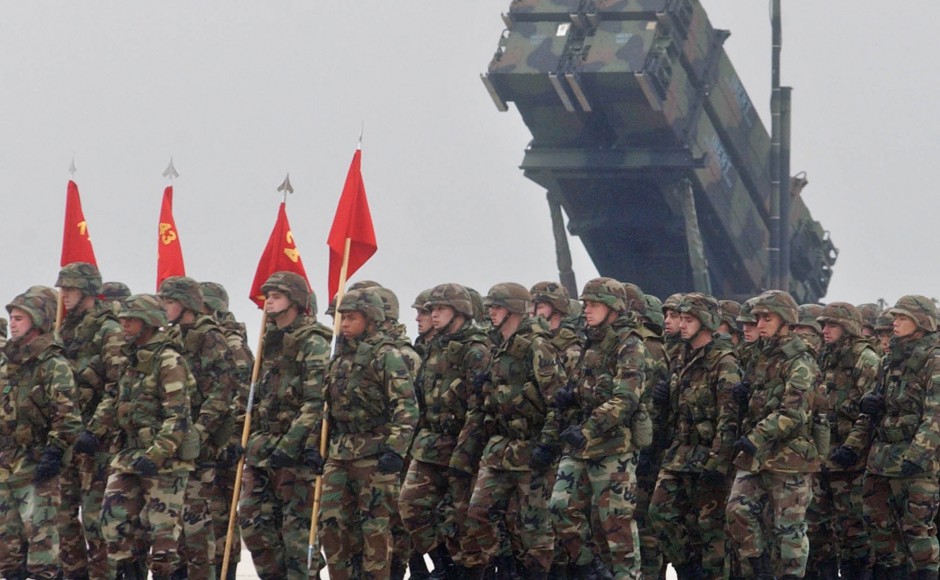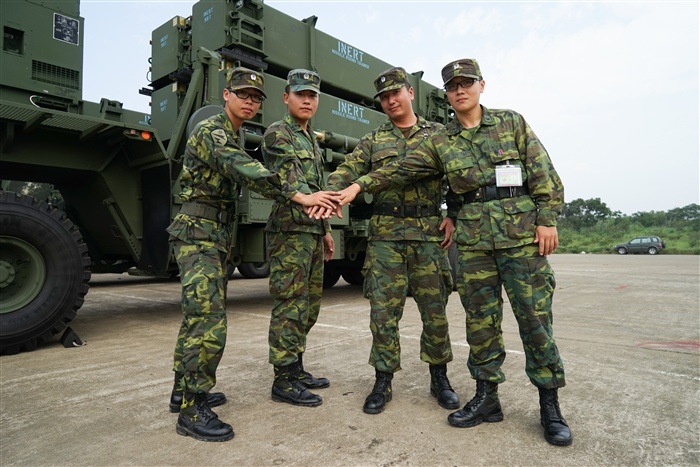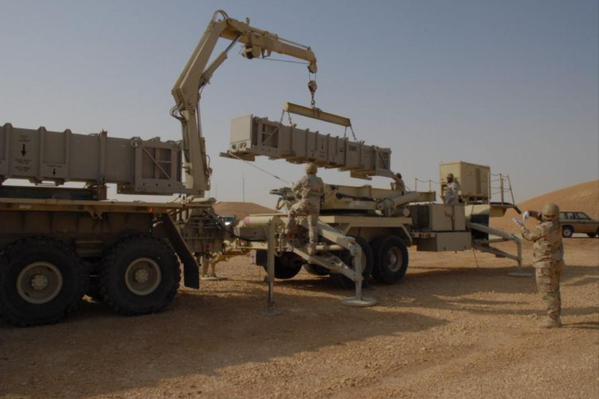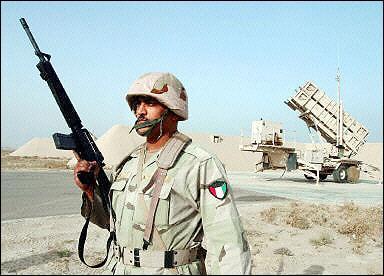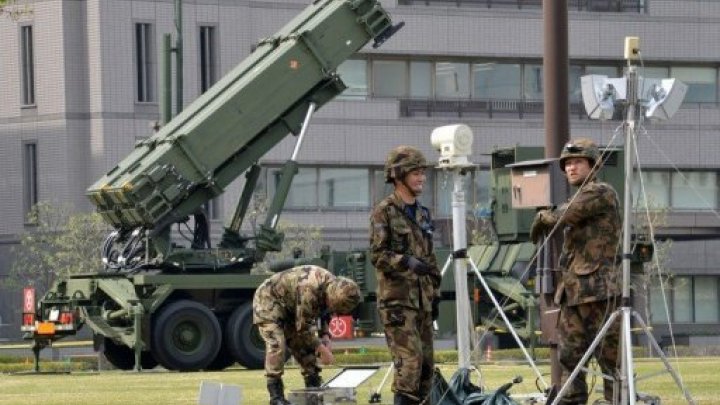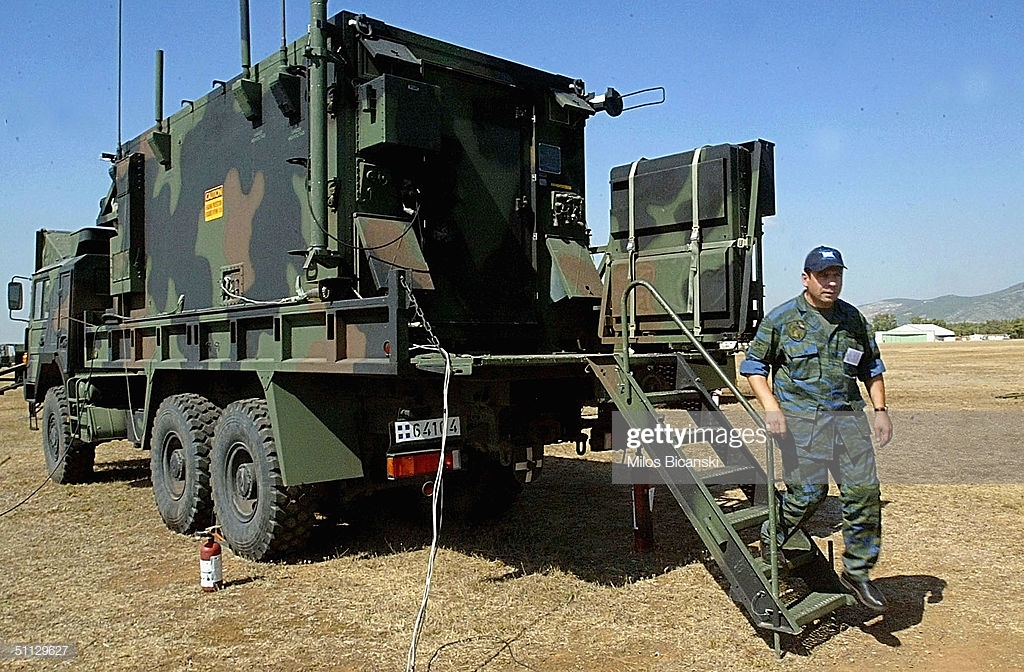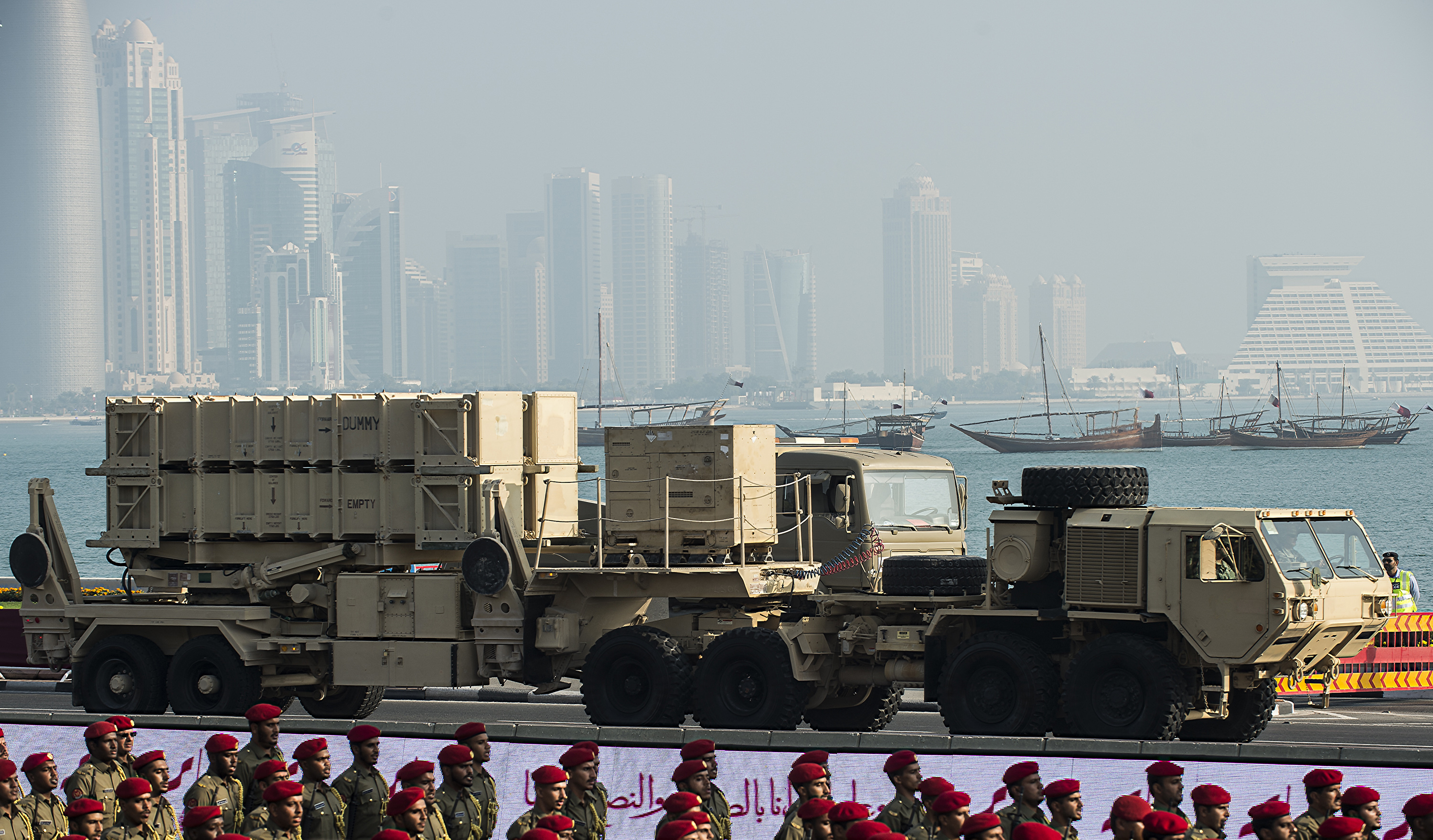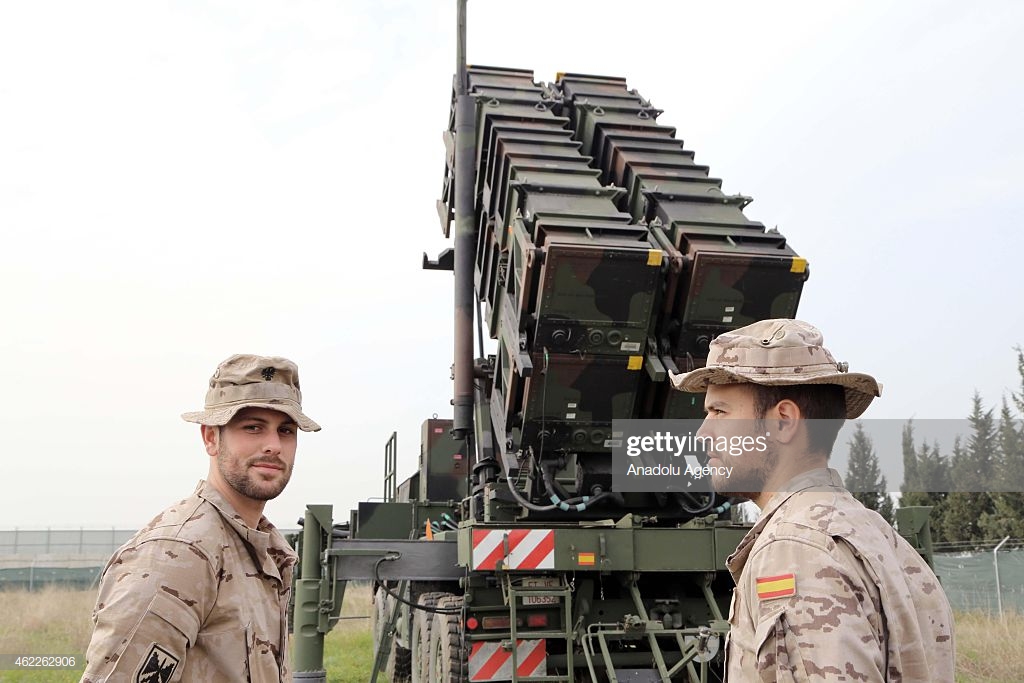
Patriot is a long-range, all-altitude, all-weather air defence system to counter tactical ballistic missiles, cruise missiles and advanced aircraft. Patriot (MIM-104) is produced by Raytheon in Massachusetts and Lockheed Martin Missiles and Fire Control in Florida.
As well as the US, Patriot is in service in Egypt, Germany, Greece, Israel, Japan, Kuwait, the Netherlands, Saudi Arabia and Taiwan.
Patriot missile systems were deployed by US forces during the 2003 Iraq conflict. The systems were stationed in Kuwait and successfully destroyed a number of hostile surface-to-surface missiles, using the new PAC-3 and guidance enhanced missiles.
Guidance enhanced missile (GEM-T) upgrade
The Patriot missile is equipped with a track-via-missile (TVM) guidance system. Midcourse correction commands are transmitted to the guidance system from the mobile engagement control centre.
"Patriot missile systems were deployed by US forces during the 2003 Iraq conflict."
The target acquisition system in the missile acquires the target in the terminal phase of flight and transmits the data using the TVM downlink via the ground radar to the engagement control station for final course correction calculations. The course correction commands are transmitted to the missile via the missile track command uplink. The high-explosive 90kg warhead is situated behind the terminal guidance section.
The range of the missile is 70km and maximum altitude is greater than 24km. The minimum flight time is the time to arm the missile, which is less than nine seconds, and the maximum flight time is less than three and a half minutes.
Raytheon has developed the Patriot guidance enhanced missile (GEM-T), an upgrade to the PAC-2 missile. The upgrade involves a new fuse and the insertion of a new low noise oscillator, which increases the seeker's sensitivity to low radar cross-section targets.
The GEM-T missile provides an upgraded capability to defeat air-breathing, cruise and ballistic missiles, as a complement to the PAC-3 missile. The first upgrade forebodies were delivered to the US Army in November 2002.
By September 2010, a total of 1,000 Patriot missiles were upgraded for the US Army.
In July 2008, South Korea placed an order for 64 GEM-T upgrade kits. In April 2011, US Army Aviation and Missile Command awarded a $58.3m contract to upgrade 131 PAC-2 missiles to GEM-T missile configuration.
In July 2008, South Korea placed an order for 64 GEM-T upgrade kits.
Related Suppliers
BEI Precision Systems & Space Company - Optical Encoders, Scanners and Accelerometers
BEI Precision Systems & Space Company designs and manufactures...
Gichner Systems Group - Mobile Tactical Shelters
Gichner Systems Group, a Kratos company, is the industry leader in...
DHS Systems - DRASH Quick-Erect Rugged Shelters
DHS Systems International is the global provider of Deployable Rapid...
ISO Group - Spare Parts, Components and Logistics for Military Vehicles and Land Equipment
ISO Group, headquartered in West Melbourne, Florida, is a world leader...
MS Kennedy Corporation - Custom Hybrids, Motor Drives and Power Modules for Army Aircraft and Weapons Systems
MS Kennedy Corporation supplies hybrid microelectronics for major...
See all suppliers
Patriot advanced capability (PAC-3) missile
A new Patriot advanced capability (PAC-3) missile has increased effectiveness against tactical ballistic and cruise missiles, through the use of advanced hit-to-kill technology. Lockheed Martin is the prime contractor, with Raytheon the systems integrator. The PAC-3 has a Ka-band millimetre wave seeker developed by Boeing.
The missile guidance system enables target destruction through the kinetic energy released by hitting the target head-on. 16 PAC-3 missiles can be loaded on a launcher, compared to four PAC-2 missiles.
"A new Patriot advanced capability (PAC-3) missile has increased effectiveness against tactical ballistic and cruise missiles."
PAC-3 entered low-rate initial production in late-1999 and first LRIP production missiles of a total of 92 were delivered in September 2001. A contract for 88 missiles was placed in December 2002 and another for 12 in March 2003.
The missile was first deployed during the Iraq conflict in March / April 2003. In February 2004, Lockheed Martin was awarded a production contract for 159 PAC-3 missiles, which includes 22 missiles to replace those expended in Iraq. Deliveries were concluded by April 2006.
A further contract for 156 missiles was received in February 2005. Of these missiles, 32 are for the Netherlands and 16 for Japan, under foreign military sales (FMS) agreements. The Netherlands received the first PAC-3 missiles in October 2007. The US Army ordered another 112 missiles in May 2006 and 112 in March 2007.
Lockheed Martin was awarded a contract in January 2007 for the risk reduction / concept definition of a programme for an air-launched Patriot PAC-3 missile system. The F-15C fighter would be the first aircraft to be fitted with the system.
In December 2007, the United Arab Emirates requested the foreign military sale of the Patriot system, including nine Patriot launchers, 288 PAC-3 missiles, 216 Patriot GEM-T missiles. The contract was awarded in December 2008. Kuwait has also requested 80 PAC-3 missiles and 60 GEM-T upgrade kits, a contract for the first six upgrade kits was placed in July 2008. In April 2008, Taiwan placed an order for a number of PAC-3 upgrade kits and, in October 2008, requested the sale of 330 PAC-3 missiles.
In January 2012, the US Army placed several contracts totalling $921m for PAC-3 missiles and associated systems. A $755m contract for 168 PAC-3 missiles, 27 launcher modification kits and related equipment and services was placed in January 2013.
South Korea requested for a $404m possible foreign military sale of 112 Patriot missiles, which would be subsequently upgraded to GEM-T configuration in October 2013.
In April 2014, the US Army Aviation and Missile Command awarded a $611m contract to Lockheed Martin for the production of first PAC-3 missiles with launcher modifications kits.
The US Army Aviation and Missile Command placed a $212m contract with Lockheed Martin to provide PAC-3 maintenance and surveillance services to the US and international customers in July 2014.
In October 2014, Lockheed Martin was selected by the Government of Qatar to produce PAC-3 missile and command launch system for the Qatar Air Force. In the same month, the US State Department approved a possible foreign military sale of 202 Patriot
air defence systems with PAC-3 enhancement and support equipment to the Kingdom of Saudi Arabia at an estimated cost of $1.75bn.
The US State Department approved a possible FMS of PAC-3 missiles and support equipment to South Korea at an estimated cost of $1.405bn in November 2014.
PAC-3 missile segment enhancement (MSE)
The PAC-3 missile segment enhancement (MSE) is part of a spiral development being undertaken by Lockheed Martin.
The increased range MSE gives the missile a more powerful rocket motor for added thrust and larger fins for increased manoeuvrability against faster and more sophisticated ballistic and cruise missiles. The MSE began flight testing in May 2008.
The PAC-3 MSE is the baseline interceptor for the multinational medium extended air defence system (MEADS) under a contract placed in February 2008. The missile was successfully test fired using the Patriot system in May 2011. Lockheed Martin was awarded a $68.9m contract in July 2012 to prepare the PAC-3 production line for the PAC-3 MSE missile.
The PAC-3 MSE successfully destructed a tactical ballistic missile (TBM) target at White Sands Missile Range in December 2012.
The US Army Aviation and Missile Command awarded a $308m contract modification to Lockheed Martin for hardware and services associated with the PAC-3 missile segment programme in August 2013.
M901 launching station
The M901 launching station transports, points and launches the Patriot missile. Each launcher has four missiles. The launcher is remotely operated via a VHF or fibre-optic data link from the engagement control station, which provides both the missile prelaunch data and the fire command signal.
Engagement control station
The AN/MSQ-104 engagement control station is the only manned station in a Patriot fire unit. The control station communicates with the M901 launching stations, with other Patriot batteries and the higher command headquarters.
The control station is manned by three operators, who have two consoles and a communications station with three radio relay terminals. The digital weapon control computer is located next to the VHF data link terminals.
Radar on the air defence system
The AN/MPQ-53 phased array radar carries out search, target detection, track and identification, missile tracking and guidance and electronic counter-countermeasure (ECCM) functions. The radar is mounted on a trailer and is automatically controlled by the digital weapons control computer in the engagement control station, via a cable link. The radar system has a range of up to 100km, capacity to track up to 100 targets and can provide missile guidance data for up to nine missiles.
The US Army Patriot radars are being upgraded by Raytheon. The upgrade kits provide greater power for the radar and the addition of a wideband capability for improved target discrimination.
A target engagement can be carried out in manual, semi-automatic or automatic mode. When the decision has been made to engage the target, the engagement control station selects the launch station or stations and pre-launch data is transmitted to the selected missile. After launch, the Patriot missile is acquired by the radar.
The command uplink and the TVM downlink allow the missile's flight to be monitored and provide missile guidance commands from the weapon control computer. As the missile approaches the target, the TVM guidance system is activated and the missile is steered towards the target. A proximity fuse detonates the high-explosive warhead.
Orders and deliveries
Raytheon received a $235.5m contract to advance the Patriot system with radar digital processor (RDP) kits for the US and two partner nations in July 2014. The US Army Aviation and Missile Command awarded a $109m engineering services contract to Raytheon for its Patriot system in September 2014.
Raytheon received a $2.4bn FMS contract to provide new-production fire units of the Patriot system to Qatar in December 2014.
In March 2014, Raytheon received a $655m contract from the US Army Aviation and Missile Command for providing new-production fire units of Patriot system to Kuwait.
The US Government approved the export of a Gallium Nitride-(GaN) based active electronically scanned array (AESA) Patriot sensor to Patriot system partner nations in February 2015.
In April 2015, Raytheon received a $2bn international order to provide fully digitised new-production Patriot fire units with the latest technology for enhanced threat detection, identification and engagement. In the same month, the Patriot system was selected by Poland for its Wisla integrated air and missile defence programme.
Raytheon received a $212m contract from the US Army for the improvement of Patriot air and missile defence system in April 2015.
http://www.army-technology.com/projects/patriot/







